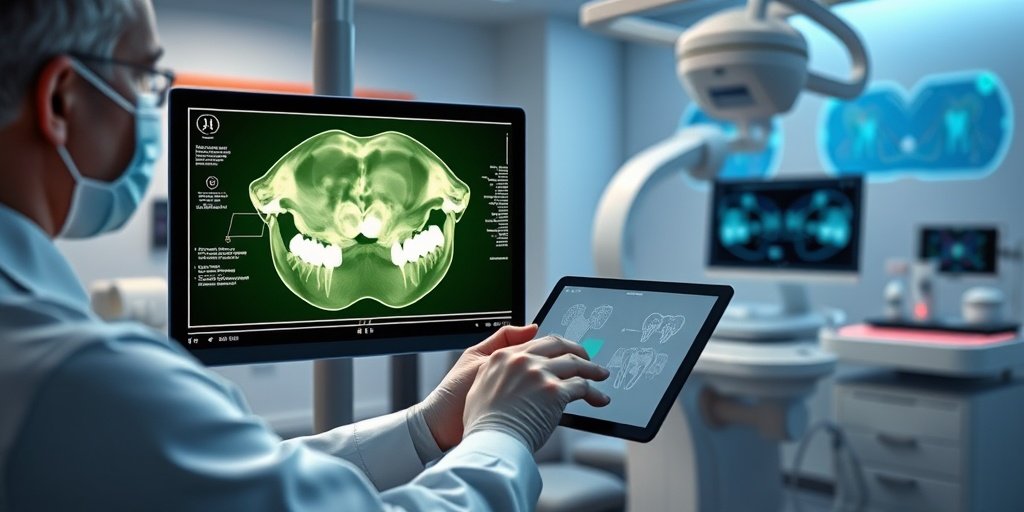⚡ Quick Summary
This study introduces a novel AI-based diagnostic pipeline for assessing the relationship between the maxillary sinus and maxillary molars using CBCT images. The implementation of Detectron2 with faster R-CNN R50 FPN 3x achieved an impressive 89% accuracy, enhancing preoperative planning and patient safety in dental procedures.
🔍 Key Details
- 📊 Technology Used: Detectron2 with faster R-CNN R50 FPN 3x
- 🧩 Imaging Modality: Cone Beam Computed Tomography (CBCT)
- 🏆 Accuracy: 89% in classifying anatomical structures
- ⚙️ Purpose: To detect and classify maxillary sinus-maxillary molar relationships
🔑 Key Takeaways
- 🦷 Enhanced diagnostic capabilities for dental professionals.
- 🤖 AI technology significantly reduces manual evaluation time.
- 📈 Improved risk assessment for surgical complications like sinus perforation.
- 💡 Potential for early detection of maxillary sinus pathologies.
- 🏥 Streamlined workflow for clinicians, enhancing treatment planning.
- 🌍 Study published in BMC Oral Health, highlighting its clinical relevance.

📚 Background
The relationship between the maxillary sinus and maxillary molars is crucial in dental procedures, particularly in tooth extractions, implant placements, and periodontal surgeries. Traditional methods of assessing these relationships can be time-consuming and prone to human error. The integration of advanced imaging techniques and artificial intelligence offers a promising solution to enhance diagnostic accuracy and efficiency in dental practice.
🗒️ Study
This study focused on developing an AI-driven model to automatically detect and classify the anatomical relationships between the maxillary sinus and adjacent molars in CBCT images. By leveraging the capabilities of Detectron2 and faster R-CNN R50 FPN 3x, the researchers aimed to provide a more reliable and efficient diagnostic tool for clinicians.
📈 Results
The results demonstrated that the AI algorithm achieved a remarkable 89% accuracy in classifying the anatomical structures. This performance indicates a significant improvement over traditional manual evaluations, providing faster and more consistent results, which is essential for effective preoperative planning.
🌍 Impact and Implications
The implications of this study are profound for the field of dentistry. By utilizing AI-powered image analysis, clinicians can enhance their ability to assess risks associated with surgical procedures, ultimately improving patient safety. This technology not only streamlines the diagnostic process but also has the potential to assist in the early detection of maxillary sinus pathologies, paving the way for better treatment outcomes.
🔮 Conclusion
This study highlights the transformative potential of integrating AI technology into dental diagnostics. The enhanced accuracy and efficiency provided by the AI model can significantly improve clinical decision-making in oral and maxillofacial surgery. As we continue to explore the capabilities of AI in healthcare, it is clear that such innovations will play a crucial role in shaping the future of dental practice.
💬 Your comments
What are your thoughts on the integration of AI in dental diagnostics? We would love to hear your insights! 💬 Leave your comments below or connect with us on social media:
Enhanced diagnostic pipeline for maxillary sinus-maxillary molars relationships: a novel implementation of Detectron2 with faster R-CNN R50 FPN 3x on CBCT images.
Abstract
BACKGROUND: The anatomical relationship between the maxillary sinus and maxillary molars is critical for planning dental procedures such as tooth extraction, implant placement and periodontal surgery.
METHODS: This study presents a novel artificial intelligence-based approach for the detection and classification of these anatomical relationships in cone beam computed tomography (CBCT) images. The model, developed using advanced image recognition technology, can automatically detect the relationship between the maxillary sinus and adjacent molars with high accuracy.
RESULTS: The artificial intelligence algorithm used in our study provided faster and more consistent results compared to traditional manual evaluations, reaching 89% accuracy in the classification of anatomical structures.
CONCLUSIONS: With this technology, clinicians will be able to more accurately assess the risks of sinus perforation, oroantral fistula and other surgical complications in the maxillary posterior region preoperatively. By reducing the workload associated with CBCT analysis, the system accelerates clinicians’ diagnostic process, improves treatment planning and increases patient safety. It also has the potential to assist in the early detection of maxillary sinus pathologies and the planning of sinus floor elevation procedures. These findings suggest that the integration of AI-powered image analysis solutions into daily dental practice can improve clinical decision-making in oral and maxillofacial surgery by providing accurate, efficient and reliable diagnostic support.
Author: [‘Özemre MÖ’, ‘Bektaş J’, ‘Yanik H’, ‘Baysal L’, ‘Karslioğlu H’]
Journal: BMC Oral Health
Citation: Özemre MÖ, et al. Enhanced diagnostic pipeline for maxillary sinus-maxillary molars relationships: a novel implementation of Detectron2 with faster R-CNN R50 FPN 3x on CBCT images. Enhanced diagnostic pipeline for maxillary sinus-maxillary molars relationships: a novel implementation of Detectron2 with faster R-CNN R50 FPN 3x on CBCT images. 2025; 25:1473. doi: 10.1186/s12903-025-06337-z